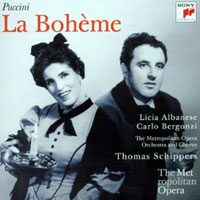Puccini • La Bohème Metropolitan Opera Orchestra and Chorus; Thomas Schippers, conducting
Puccini • Tosca
La Bohème premiered at the Teatro Regio in Turin on February 1, 1896 and immediately received a cool reception by the local press. The opera is based on Henri Murger's 1848 novel Scenes de la vie boheme in which the author, it is believed, created the myth of the idealistic young artist starving in a local garret. Tosca met with a similar public outcry of sorts after its premiere in Rome at the Teatro Costanzi on June 14, 1900. Curiously, the libretto for Tosca was based on Victorien Sardou's 1887 play La Tosca, which the acclaimed actress Sarah Bernhardt made famous in theaters throughout Europe. Despite rather mixed reviews, Tosca quickly became the worldwide success Puccini had anticipated. The endurance of both popular works remains. La Bohème and Tosca are two of the most-performed and best-loved operas, perpetuated by generations of fans attending frequent, annual performances given around the world. Taped from a live broadcast performed at the Metropolitan Opera House on February 14, 1958, this Sony Masterworks recording of La Bohème features Licia Albanese in the role of Mimi, Carlo Bergonzi as Rodolfo, and Mario Sereni in the part of Marcello. Thomas Schippers leads the opera orchestra and chorus. Albanese was closely associated with roles as heroines during her lengthy career and frequently played the role of the ill-fated Mimi. On these discs, she sings her role with a sturdy, vibrant voice, gaining greater warmth in timbre as the opera unfolds toward its concluding act. Sometimes, however, her singing sounds a bit on edge, and she can lack a certain youthful quality in comparison with, say, Mirella Freni in the same role. Bergonzi, a young tenor who was always considered by public opinion a paragon of the Italian tradition, has a voice in full bloom on this recording -- genial, in excellent form, producing proper diction and tone. The appealing baritone Sereni accords his role with distinction and sings with remarkable fluidity in scenes with Bergonzi. Schippers is always in firm control of his orchestral forces, and the musicians play beautifully throughout the score. This Tosca was originally recorded on the afternoon of April 7, 1962 and headed by a stellar cast, including Leontyne Price, Franco Corelli, and Cornell MacNeil in the principal roles. At the time, all of these artists were at the peak of their remarkable careers. Moreover, on that day, their performances were superb. Most opera elitists will argue that the combined vocal skills of Callas, DiStefano and Gobbi in their respective roles in Tosca represent the pinnacle interpretation of this most widely recorded Puccini opera. No argument on this point. Nonetheless, Price, Corelli and MacNeil pretty much hit a home run of their own with their magnificent stamp on this dramatic work, Puccini's most violent, in unique gradations. Price, with her sumptuous voice, unleashes torrents of gorgeous, expressive sounds along with motifs ascending and descending musical scales with agility and accuracy. Corelli's unique vocal qualities produce a rich, lustrous voice demonstrating his art as a fearless tenor projecting dark, nearly low and middle tones as well as high notes of virtual steel. In his moving aria, "E lucevan le stelle," Corelli's Cavaradossi is equating love with death, which the artist conveys with extraordinary expressiveness and passion. Likewise, Price's tender aria, "Vissi d'arte, vissi d'amore," which is heard at the center of the most violent scene in the opera, is brilliantly sung in an emotional way that lovingly radiates the sheer, sublime sounds of the opera's musical opulence and drama. As Baron Scarpia, one of the most villainous characters in all of operatic repertoire, MacNeil straightforwardly portrays his despicable mien as a cruel, brutal, scurrilous executioner with remarkable skill and mastery of voice control. When he intones his expostulations to Tosca and others, chills run up and down one's spine in fear of ominous remonstrations and actions. Scarpia is indeed a great role that requires the incredible talents of a first-class performer on the order of a Gobbi, Leiferkus or MacNeil to carry off its enormous vocal demands. My only quibble with these two-CD sets is sonic in nature. At times, more on the La Bohème discs than on Tosca, the combined voices sound somewhat dry and a bit distant, perhaps the fault of the age of the productions and the less-sophisticated recording techniques applied at the time. The clarity and strength of the voices that come through on the Tosca discs are highly distinctive. For historical collectors, however, it should be pointed out that this version of La Bohème with Albanese and Bergonzi first appeared on the Gala label, while in the case of Tosca, the cast ensemble of Price, Corelli and MacNeil showed up earlier on the Myrto label. Together these Sony Masterworks operas have held up
reasonably well despite their live-broadcast heritage, as the performers displayed great
art and sensitivity in achieving the composer's wishes and goals. The sound engineers have
accomplished a commendable feat in restoring these performances without any significant
distractions, except for the occasional audience cough or two. |


